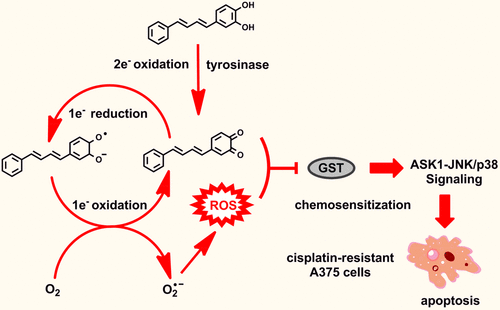当前位置:
X-MOL 学术
›
J. Agric. Food Chem.
›
论文详情
Our official English website, www.x-mol.net, welcomes your
feedback! (Note: you will need to create a separate account there.)
Identification of Catechol-Type Diphenylbutadiene as a Tyrosinase-Activated Pro-oxidative Chemosensitizer against Melanoma A375 Cells via Glutathione S-Transferase Inhibition
Journal of Agricultural and Food Chemistry ( IF 5.7 ) Pub Date : 2019-07-24 00:00:00 , DOI: 10.1021/acs.jafc.9b02875 Yuan Ji 1 , Fang Dai 1 , Shuai Yan 1 , Jing-Yang Shi 1 , Bo Zhou 1
Journal of Agricultural and Food Chemistry ( IF 5.7 ) Pub Date : 2019-07-24 00:00:00 , DOI: 10.1021/acs.jafc.9b02875 Yuan Ji 1 , Fang Dai 1 , Shuai Yan 1 , Jing-Yang Shi 1 , Bo Zhou 1
Affiliation

|
Glutathione S-transferases (GSTs) play an active role in the development of drug resistance by numerous cancer cells, including melanoma cells, which is a major cause of chemotherapy failure. As part of our continuous effort to explore why dietary polyphenols bearing the catechol moiety (dietary catechols) show usually anticancer activity, catechol-type diphenylbutadiene (3,4-DHB) was selected as a model of dietary catechols to probe whether they work as pro-oxidative chemosensitizers via GST inhibition in melanoma cells. It was found that, in human melanoma A375 cells, 3,4-DHB is easily converted to its ortho-quinone via copper-containing tyrosinase-mediated two-electron oxidation along with generation of reactive oxygen species (ROS) derived from the oxidation; the resulting ortho-quinone and ROS are responsible for its ability to sensitize the cisplatin-resistant cells by inhibiting GST, followed by induction of apoptosis in an ASK1-JNK/p38 signaling cascade and mitochondria-dependent pathway. This work provides further evidence to support that dietary catechols exhibit antimelanoma activity by virtue of their tyrosinase-dependent pro-oxidative role and gives useful information for designing polyphenol-inspired GST inhibitors and sensitizers in chemotherapy against melanoma.
中文翻译:

通过谷胱甘肽S-转移酶抑制来鉴定邻苯二酚型二苯基丁二烯作为酪氨酸酶激活的对黑色素瘤A375细胞的促氧化化学增敏剂
谷胱甘肽S-转移酶(GST)在包括黑素瘤细胞在内的众多癌细胞的耐药性发展中起积极作用,这是化疗失败的主要原因。为了不断探索为什么为什么含有儿茶酚部分的膳食多酚(饮食中的儿茶酚)通常具有抗癌活性,我们选择了儿茶酚型二苯丁二烯(3,4-DHB)作为饮食中的儿茶酚模型,以探究它们是否以亲黑色素瘤细胞中通过GST抑制产生的氧化型化学增敏剂。已经发现,在人黑素瘤A375细胞中,通过含铜的酪氨酸酶介导的二电子氧化容易地将3,4-DHB转化为其邻醌,并产生源自氧化的活性氧(ROS)。所结果的邻-quinone和ROS负责其通过抑制GST致敏的顺铂耐药的细胞的能力,其次是细胞凋亡的诱导在ASK1-JNK / p38信号级联和线粒体依赖性途径。这项工作提供了进一步的证据来支持饮食中的儿茶酚由于其酪氨酸酶依赖性的促氧化作用而表现出变色瘤活性,并为设计多酚类GST抑制剂和敏化剂在针对黑素瘤的化学疗法中设计提供了有用的信息。
更新日期:2019-07-24
中文翻译:

通过谷胱甘肽S-转移酶抑制来鉴定邻苯二酚型二苯基丁二烯作为酪氨酸酶激活的对黑色素瘤A375细胞的促氧化化学增敏剂
谷胱甘肽S-转移酶(GST)在包括黑素瘤细胞在内的众多癌细胞的耐药性发展中起积极作用,这是化疗失败的主要原因。为了不断探索为什么为什么含有儿茶酚部分的膳食多酚(饮食中的儿茶酚)通常具有抗癌活性,我们选择了儿茶酚型二苯丁二烯(3,4-DHB)作为饮食中的儿茶酚模型,以探究它们是否以亲黑色素瘤细胞中通过GST抑制产生的氧化型化学增敏剂。已经发现,在人黑素瘤A375细胞中,通过含铜的酪氨酸酶介导的二电子氧化容易地将3,4-DHB转化为其邻醌,并产生源自氧化的活性氧(ROS)。所结果的邻-quinone和ROS负责其通过抑制GST致敏的顺铂耐药的细胞的能力,其次是细胞凋亡的诱导在ASK1-JNK / p38信号级联和线粒体依赖性途径。这项工作提供了进一步的证据来支持饮食中的儿茶酚由于其酪氨酸酶依赖性的促氧化作用而表现出变色瘤活性,并为设计多酚类GST抑制剂和敏化剂在针对黑素瘤的化学疗法中设计提供了有用的信息。















































 京公网安备 11010802027423号
京公网安备 11010802027423号